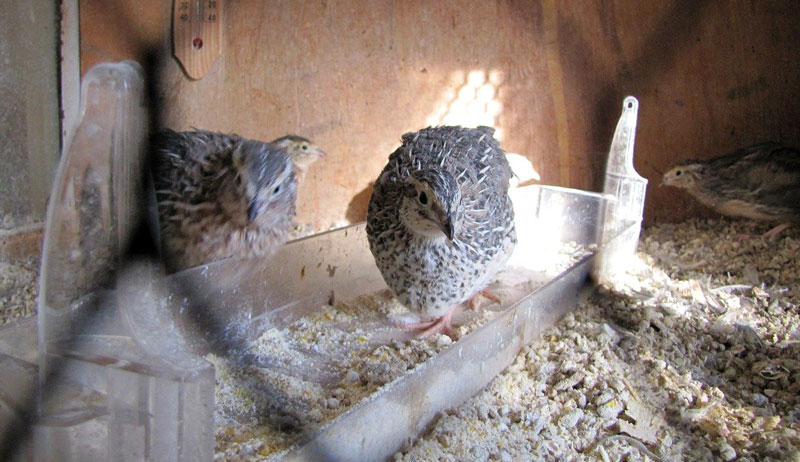
Listen, we all love chickens. They give food, entertain us and act as companions. It’s not difficult to find housing and supplies, and they’re legal in a lot of urban and suburban areas. And the learning curve for getting started with chickens is fairly low, thanks to a wealth of available instruction. (You’re welcome)
But chickens are not the only domesticated fowl that one can keep. And for many, quail could actually be a better option than chickens.
I know … what? But chickens aren’t small animals (O.K., bantams are pretty little), so they do have considerable space requirements. Hens can get pretty noisy, too. And a particularly flighty bird can be problematic for chicken-keepers in small areas.
Let’s take a look at some of the benefits quail have over chickens and look into how to raise them.
Meet the adorable quail running around Alchemist Farm!
Eggs
First, consider the eggs. Yes, quail eggs are very small, and you’ll need multiple eggs to equal what you’d normally get from a chicken.
But quail are extremely efficient layers. It’s believed that one bird will lay around 300 eggs a year (though the quail market is too small to produce any official data). And where chickens take their sweet time to start laying, quail usually start producing eggs around 8 weeks of age.
And quail are very good at converting the feed you give them into high-protein eggs. This means that you spend less to get a particular weight of quail eggs than you would to get the same weight in chicken eggs. Depending on the breed of chicken you’re comparing against, the difference can actually be quite a lot.
Considering the premium quail eggs bring at market or sold to high-end restaurants, you can see that these little eggs come with big profit potential.
Meat
While backyard bird keepers might not be interested in raising quail for meat, the small fowl do present opportunities in this area for small farmers. (Though it’s worth noting that feed conversion efficiency is not one of benefits quail have over chickens.)
The small birds are much easier to harvest than chickens. They’re simple to cook (“It’s tough to go wrong,” says Mark Bittman) and have a taste distinctive from chicken, with a gamey flavor that’s milder than other game birds, such as grouse or woodcock.
The real kicker, though, is that the birds are truly dual-purpose. Once an egg-laying chicken’s high-production period is over—usually around a year—the birds’ meat has toughened. When these birds are culled (again, not common practice among backyard chicken keepers, but necessary for egg operations), the meat’s usage is limited to boiling. Old hens make a great soup, but you don’t want to fry or roast one.
But you don’t necessarily have the same concerns with quail. So after an egg-laying bird’s production starts to fall off (also around a year of age), the meat will be more versatile for cooking purposes. Some claim it’s even good fried.
It’s worth noting, though, that, like the eggs, you need more quail meat to make a meal—generally, two full birds are a single serving.

How to Raise Quail
Right at the top, let’s recognize one thing—more people might be able to raise quail than chickens, as many places that have made chicken-keeping illegal have no such laws about quail on the books. (You should check if you have doubts, though.) And one of the major benefits quail have over chickens is the noise level—they make sounds, sure, but nothing that would bother neighbors like a hen’s loud squawk.
You’ll want to choose a breed to raise. Most prefer the Coturnix, but you can also choose between Jumbo Bobwhite, Japanese, Button and Chinese-Painted breeds.
You’ll also need to determine how you’ll start out raising quail—you can purchase chicks at hatcheries, but minimums are often between 50 and 100. You can also purchase hatching eggs and necessary equipment. Or you can find a breeder who will sell you some birds of the number and age you’re looking for.
Here’s where we’re going to lose some chicken-keepers—quail really do better in battery cages, and most people keep them up off the ground to prevent worms. (Though you can treat for worms if you’d prefer they have some dirt beneath their feet.)
This is a drawback for free-range enthusiasts, for sure. But for people with space constraints, the birds’ minimal requirements—1 square foot per bird—can actually be a plus. You can put a dust bath and some branches in the cages for a more natural environment.
You will also have to provide feeders and waterers, which need to be refilled daily. Quail nutritional needs are not the same as chickens and can vary based on breed and your reasons for keeping them. This feeding guide from the Mississippi State University Extension provides in-depth information regarding feeding quail.
So are quail better than chickens? Of course that’s a ridiculous question—you can raise either or both with full satisfaction.
But for some people, it’s true that quail have benefits over chickens—primarily, the fact that they can often be raised where poultry aren’t an option. And for small farmers, the little birds offer a potential additional revenue stream.




